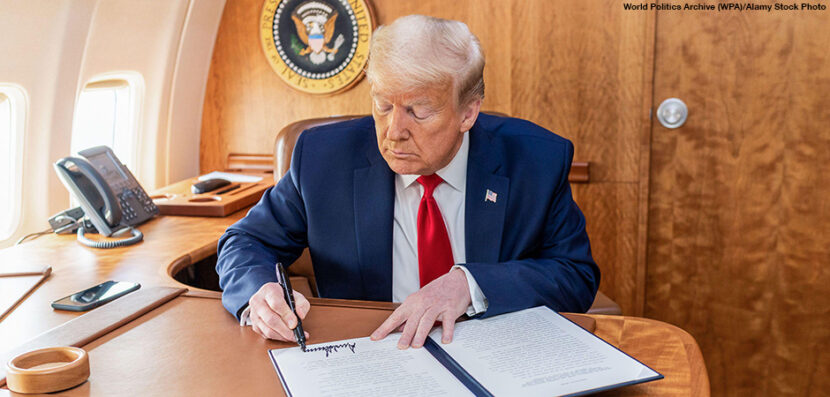
The Impact of Trump’s Tariff Plan
On April 2, 2025, on what he called “Liberation Day,” President Trump unveiled a new plan to place tariffs on goods from all over the world. He announced that the U.S. has suffered from unfair trade practices in the past, and that his tariff plan will strengthen the U.S. economy. The plan puts a baseline 10 percent tariff on all foreign goods imported into the United States. For some countries, the tariffs are higher. The initial order placed a 54 percent tariff for Chinese goods, a 20 percent tariff on European Union imports, and a 24 percent tariff on goods from Japan.
But what exactly is a tariff, and how will this new plan impact the nation’s economy and your wallet? Here, Election Central takes a closer look.
What is a Tariff?
We live in a global economy and countries purchase and import a wide variety of goods that were created elsewhere. For example, you might be wearing clothes that were made in China. We trade with other countries because it doesn’t make sense for every country to produce every good. For example, the U.S. climate makes it difficult to grow many of the fruits and vegetables you enjoy. But they grow well in other parts of the world and are bought and shipped to the United States.
But when you buy a shirt that was made in China, that means U.S. clothing manufacturers make less money. The U.S. government might place a tariff on those items from other countries. Now, your imported shirt–which originally might have cost you $10 now costs $12 or $15. The additional money on the price represents the tariff that has been added to the imported item.
The theory is that raising the price of imports through tariffs will make it easier for U.S. manufacturers to compete against cheaper foreign products. This theory then argues that Americans will purchase products made in America, which will lead to more U.S. jobs.
But this isn’t always the case. Protectionism–when a country tries to limit the import of foreign goods by placing high tariffs on them–may hurt an economy more than it helps. That’s because the price of everything goes up, and consumers find that they can’t afford to spend as much as they once did. In some cases, protectionism can start a global trade war, where countries place higher tariffs on each other until no one can afford to trade at all.
How Have Tariffs Been Used in the Past?
Before the Civil War (1861-1865), tariffs funded most of the United States federal budget. This meant that most of the country’s income came from tariffs. There was no federal income tax, and the federal government spent a lot less than it does today. Tariffs alone were enough to keep the country running.
In the last decades of the nineteenth century, the American industrial economy was growing and expanding rapidly. Technological advances such as the growing railroad network and electrification were transforming the country. Millions of immigrants were also entering the country, drawn by industrial job opportunities. They provided a large pool of cheap labor, which helped industry grow as well. In 1890, Congress raised tariffs on most imported items by about fifty percent. So the economy boomed–but most economists say this was because of these industrial factors, not because of the tariffs themselves. A few years later, an amendment was added to the Constitution that created an income tax. Over time, tariffs became less and less significant.
In June 1930, at the height of the Great Depression, Congress passed the Smoot-Hawley Tariff Act, which raised prices by 20 percent on agricultural imports and more than 20,000 other imported goods. The goal was to protect American farmers. But other countries responded with their own tariff hikes, making food more expensive instead of less. Overall, global trade declined by 65 percent, and the Great Depression worsened. In 1934, President Franklin Roosevelt signed the Reciprocal Trade Agreements Act, which reduced tariffs again. Since World War II, tariffs have stayed minimal and have made up only about two percent of the federal budget.
Tariffs Today
President Trump’s newly proposed tariffs have already had a drastic impact on both U.S. economy and global trade. Stock markets have gone up and down unpredictably based on how the news about tariffs changes from day-to-day. Different countries have responded to the tariffs in different ways. Nearly 70 countries, including Japan, Vietnam, and India have said they want to negotiate new trade arrangements with the United States and are willing to lower their tariffs and other restrictions on American products to get a deal. Canada and Mexico, the two largest trading partners of the United States have responded with reciprocal tariffs. This means that they will match whatever tariffs the United States places on them with their own tariffs of equal size on American products. But both countries have also indicated a willingness to negotiate. China, which is the third largest trading partner of the United States, responded by increasing its tariffs and trade restrictions against the United States and a “trade war” has ensued, with both countries continuing to raise tariffs even further on each other’s goods.
Many economists are worried that the tariffs will result in higher prices for U.S. consumers. Here’s an example: Trump has placed a 10 percent tariff on goods from Madagascar, an island off the coast of the Africa. This is one of the few places in the world where vanilla is grown. Vanilla is a common baking ingredient. The cost of producing baked goods here in the U.S. or buying vanilla at the grocery store will go up by 10 percent.
Bakeries, especially small local bakeries, may have to raise the price of their goods to offset the increased cost. If they stay in business but raise prices, then consumers who pay more for their product will have less to spend in other places–such as the produce stand down the street. If consumers spend less money at the produce stand, then the produce stand might have to shut down, lay off workers, or raise prices as well.
In this way, tariffs cause a ripple effect throughout the entire economy. In fact, many economists are calling Trump’s tariffs the most dramatic trade shock in history. The Yale Budget Lab has estimated that the new tariffs will cost every American consumer $2700 to $3400 per year.


